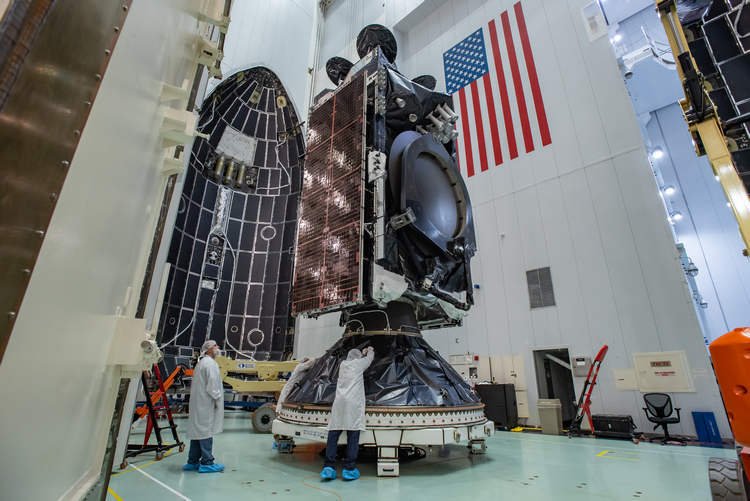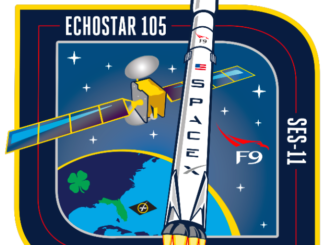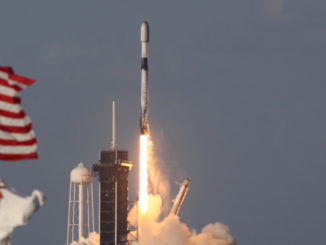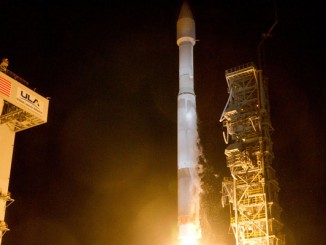
SpaceX test-fired a Falcon 9 rocket at Cape Canaveral on Saturday evening, clearing the way for a delayed liftoff with the Israeli-owned Amos 17 commercial communications satellite as soon as Tuesday, assuming SpaceX can work its way into a busy schedule before a previously-planned Atlas 5 launch this week on the U.S. Air Force’s Eastern Range.
After completing a mock countdown, the Falcon 9’s nine Merlin 1D first stage engines ignited for several seconds at 11:30 p.m. EDT Saturday (0330 GMT Sunday) at Cape Canaveral’s Complex 40 launch pad as hold-down clamps kept the rocket firmly on the ground.
SpaceX said in a tweet that team are targeting launch of the Amos 17 satellite on the Falcon 9 rocket as soon as Tuesday evening, “pending range availability.”
An Atlas 5 rocket owned by United Launch Alliance, a SpaceX rival in the launch market, is already booked on the Air Force-run range for a launch attempt Thursday morning from neighboring pad 41, more than a mile north of SpaceX’s pad 40.
SpaceX previously reserved launch attempts Saturday and Sunday on the Eastern Range, but the company bypassed those launch opportunities to resolve a technical problem.
The Falcon 9 launch delay set up the possibility for liftoffs from Cape Canaveral on Tuesday separated by less than 36 hours. Officials from the Air Force’s 45th Space Wing, which oversees the launch range at Cape Canaveral, said last year the military unit could accommodate two missions in 24 hours, thanks to recent tech upgrades.
One of the primary changes that allows a quick launch turnaround on the range is the introduction of the autonomous flight termination system, which would be enabled to destroy a rocket if it flies off course. Range safety teams also now track rockets launched from Cape Canaveral using GPS satellite data, instead of relying on ground-based radars.

The Eastern Range consists of a network of communications, tracking and safety installations used by every launch from Florida’s Space Coast. The range typically operates on a first-come, first-served basis.
Assuming the launch attempt can go forward Tuesday, liftoff of the Falcon 9 rocket with Amos 17 is scheduled for a launch window opening at 6:52 p.m. EDT (2252 GMT) and extending to 8:20 p.m. EDT (0020 GMT).
The Atlas 5’s two-hour launch window Thursday opens at 5:44 a.m. EDT (0944 GMT).
The Atlas 5 rocket will loft the Air Force’s fifth Advanced Extremely High Frequency, or AEHF, communications satellite to join a fleet of spacecraft in geostationary orbit providing secure voice, video and data links between U.S. government leaders and military commanders.
The Lockheed Martin-built AEHF satellites each cost more than $1 billion, and they form the backbone of the military’s protected satellite communications infrastructure, which the Air Force says is resilient to jamming, cyber attacks and nuclear war.
The Atlas 5 rocket slated to launch the AEHF 5 satellite is scheduled to roll out of the its vertical hangar at pad 41 Tuesday morning. Once the launcher is on the pad, ground crews will connect the Atlas 5 to electrical, data and propellant supplies in preparation for the start of the countdown Wednesday night.
Officials raised the possibility of rapid-fire Falcon 9 and Atlas 5 launches from pads 40 and 41 last year, when SpaceX was set to launch a Spanish communications satellite the same week as a new NOAA GOES geostationary weather observatory awaited liftoff on a ULA rocket.
The Atlas 5 and Falcon 9 pads at Cape Canaveral both have a “clean pad” design without a protective gantry to provide shelter for rockets after they roll out in preparation for liftoff.
The Air Force was initially prepared to support the Atlas 5 and Falcon 9 launches last year just 16-and-a-half hours apart.
Although the Falcon 9 pad is more than a mile away from the Atlas facility, ULA and NASA officials, which had responsibility for launching the NOAA weather satellite, were concerned the Atlas 5 rocket and sensitive optics on its GOES meteorological payload would be exposed to the Falcon 9’s exhaust plume as it fired into space.
Officials also studied whether the Atlas 5 and the GOES-S weather satellite might be endangered by a potential mishap during the Falcon 9 launch.
In that instance, the SpaceX launch was ultimately delayed until after the Atlas 5 rocket lifted off with the GOES weather satellite.
Air Force leaders in charge of the Eastern Range and the AEHF satellite will make the final determination on this week’s launch schedule. A launch readiness review for the Atlas 5 mission is scheduled Monday morning.
The hold-down firing Saturday was the second for the Falcon 9 rocket in the Amos 17 launch campaign, following a test-firing Wednesday evening. SpaceX decided to replace a valve after the hotfire test Wednesday night, and completed a second fueling and engine test Saturday.
Ground crews planned to remove the Falcon 9 rocket from the launch pad Sunday and return it to a hangar south of pad 40 for attachment of the Amos 17 spacecraft, already encapsulated inside its payload shroud.
The Boeing-built Amos 17 satellite is owned by Spacecom Ltd., an Israeli company based in Tel Aviv. The last time a Spacecom-owned satellite was to launch on a SpaceX rocket, the spacecraft was destroyed during an explosion minutes before a planned static fire test.
Since that accident, SpaceX has not placed one of its customer payloads on the rocket for the static fire test.

The official weather forecast suggests SpaceX’s launch team will contend with stormy conditions during a possible countdown Tuesday. There is a 60 percent chance weather conditions will be unacceptable for launch Tuesday evening, according to an outlook issued by the U.S. Air Force’s 45th Weather Squadron.
The prime weather concerns Tuesday are with the lightning and thick cloud rules. The forecast does not list a backup launch opportunity for Amos 17, presumably because the Air Force range would be unable to support a countdown Wednesday in the hours before the Atlas 5 launch.
“Thunderstorms will affect the Space Coast most of the afternoon and early evening hours which means a higher potential for weather violation at the beginning of the window,” forecasters wrote Sunday. “But as the sun sets and thunderstorms diminish in coverage, we will likely see an improving launch potential through the latter half of the launch window.”
The Falcon 9 rocket launching with Amos 17 will fly in expendable mode without any landing legs. The heavy weight of Amos 17, at some 6.5 metric tons (14,330 pounds) fully fueled, requires all of the Falcon 9’s lift performance to deliver it into a geostationary transfer orbit stretching more than 22,000 miles (nearly 36,000 kilometers) over the equator.
This will be the second time SpaceX’s has flown one of its Falcon 9 rockets in the new-generation “Block 5″ configuration without attempting a recovery of the first stage.
The booster launching with Amos 17 previously flew two times from Cape Canaveral last year to send the Telstar 19 VANTAGE and Es’hail 2 communications satellites toward orbit, then returned to landings on SpaceX’s drone ship in the Atlantic Ocean for refurbishment and reuse.
Amos 17 will use its own engine to circularize its orbit more than 22,000 miles over the equator, where it will park at 17 degrees east longitude. In geostationary orbit, Amos 17’s orbital velocity will match the rate of Earth’s rotation, giving the satellite a fixed geographic coverage area over sub-Saharan Africa, Europe, Asia and the Middle East.
Spacecom says says Amos 17 is designed for a 20-year lifetime, and the mission carries a cost of about $250 million, including the spacecraft, launch services and insurance.
“Spacecom has long been the pioneering leader in providing international satellite communication services in Israel and worldwide,” said David Pollack, Spacecom’s president and CEO. “Amos 17’s launch is a meaningful and strategic milestone that boosts Israel’s continued presence in space and our corporate growth.”

Amos 17 will replace the Amos 5 satellite at 17 degrees east, which failed in 2015. The new satellite carries C-band, Ku-band and Ka-band communications payloads to provide television broadcast, broadband Internet and other networking and data relay services.
Spacecom purchased the Amos 17 satellite in 2016 from Boeing under a $161 million contract.
The launch of Amos 17 will be the 10th flight by SpaceX’s Falcon rocket family this year.
Email the author.
Follow Stephen Clark on Twitter: @StephenClark1.



